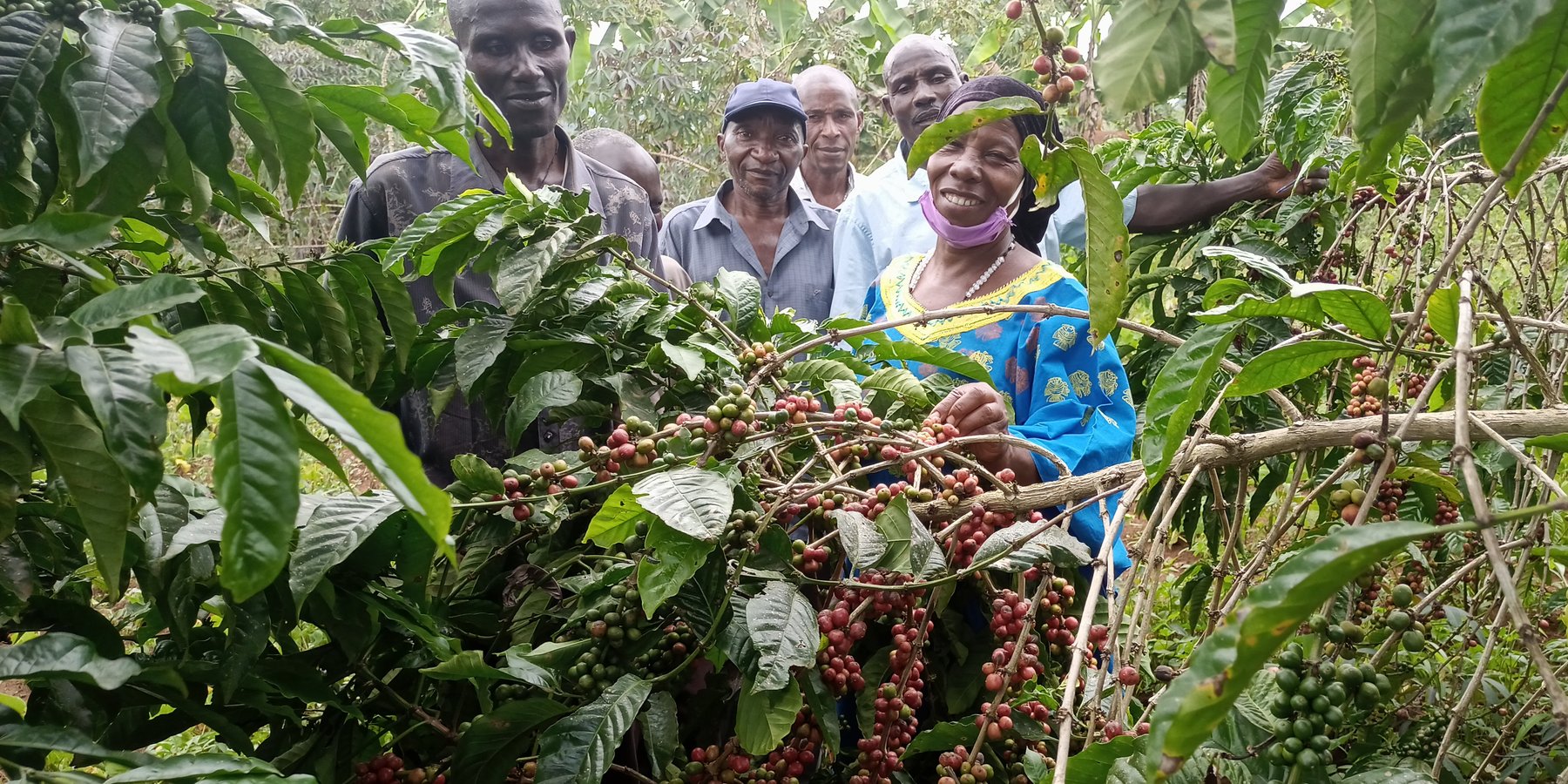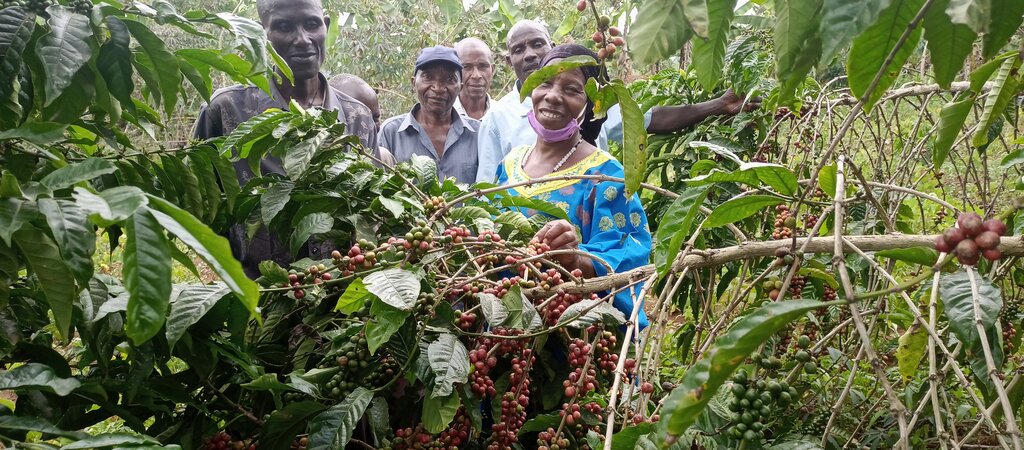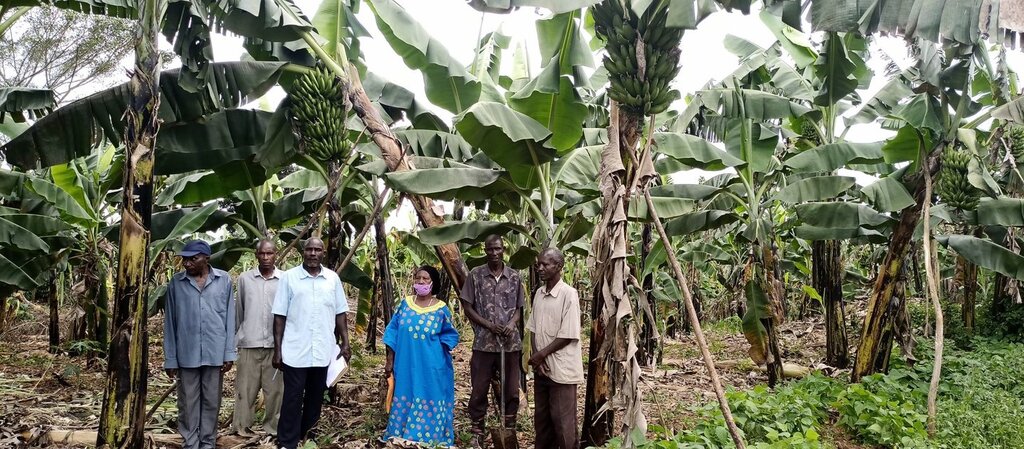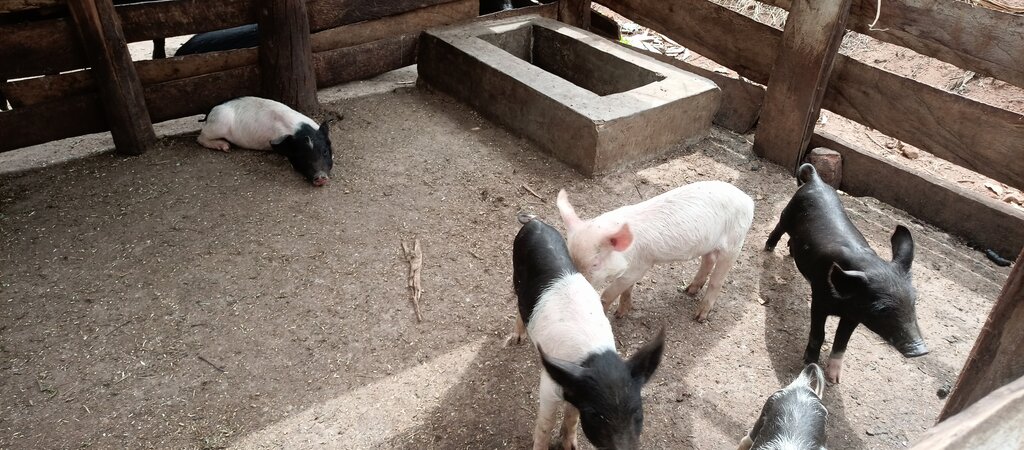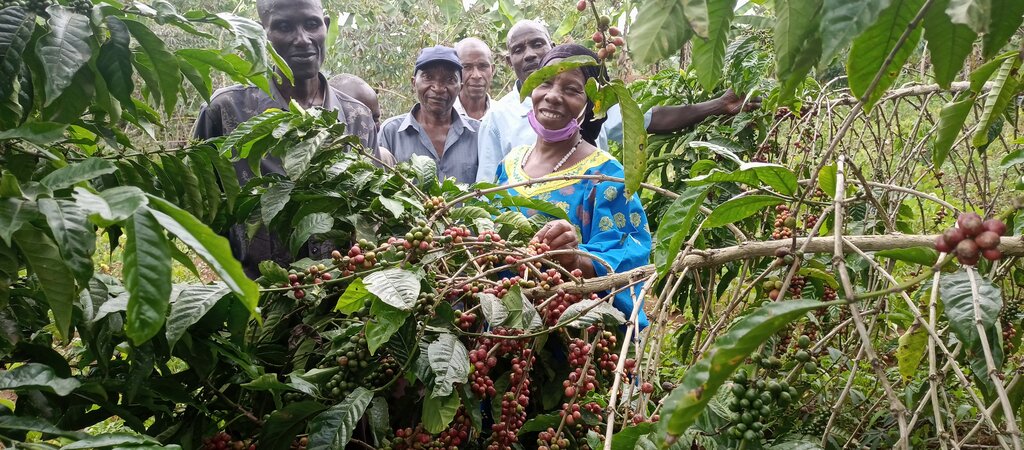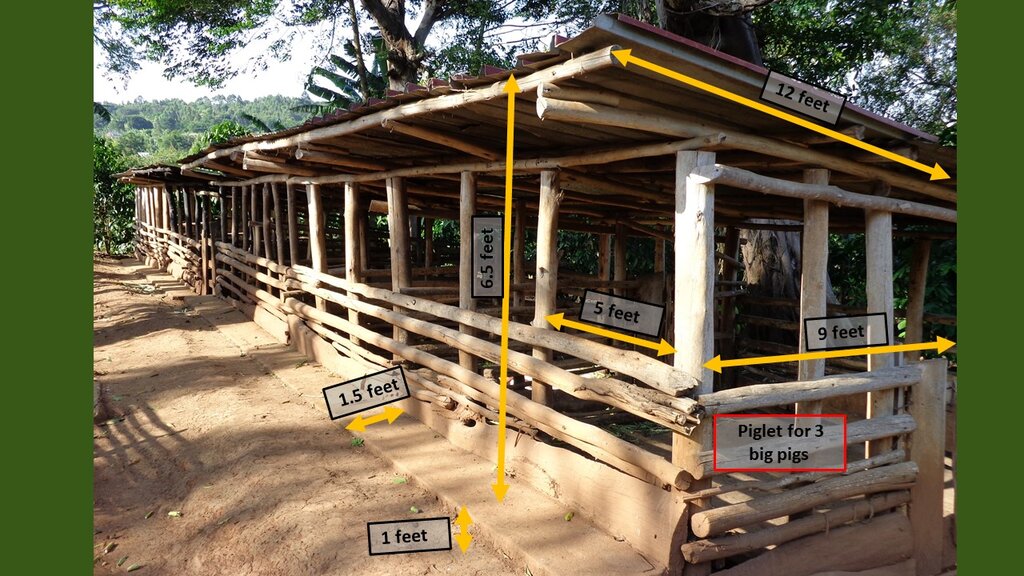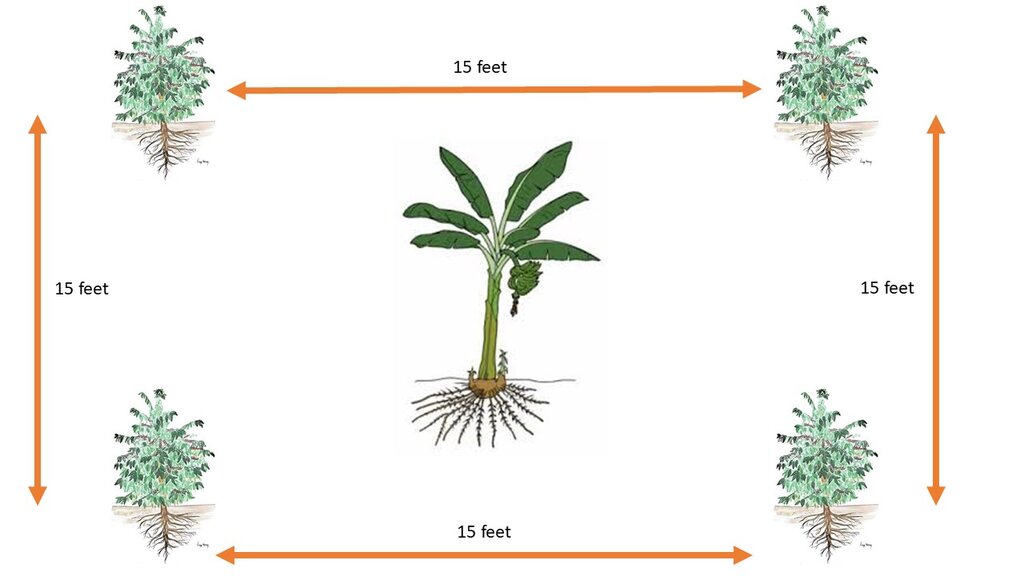Piggery-Banana-Coffee technology [Ouganda]
- Création :
- Mise à jour :
- Compilateur : Tonny Kyambadde
- Rédacteurs : Beatrice Nabukenya, Michael Mulindwa, Kyagaba Prossy, Annika Reimann
- Examinateurs : William Critchley, Rima Mekdaschi Studer
Obusa bwe mbizzi kumwanyi ne bitooke
technologies_5914 - Ouganda
Voir les sections
Développer tout Réduire tout1. Informations générales
1.2 Coordonnées des personnes-ressources et des institutions impliquées dans l'évaluation et la documentation de la Technologie
co-compiler:
Kyagaba Prossy
Caritas MADDO
Ouganda
co-compiler:
co-compiler:
Nom du projet qui a facilité la documentation/ l'évaluation de la Technologie (si pertinent)
Euregio-East Africa Livelihood Improvement Programme (EEALIP)Nom du ou des institutions qui ont facilité la documentation/ l'évaluation de la Technologie (si pertinent)
Caritas Masaka Diocesan Development Organisation (Caritas MADDO) - Ouganda1.3 Conditions relatives à l'utilisation par WOCAT des données documentées
Le compilateur et la(les) personne(s) ressource(s) acceptent les conditions relatives à l'utilisation par WOCAT des données documentées:
Oui
1.4 Déclaration sur la durabilité de la Technologie décrite
Est-ce que la Technologie décrite ici pose problème par rapport à la dégradation des terres, de telle sorte qu'elle ne peut pas être déclarée comme étant une technologie de gestion durable des terres?
Non
Commentaires:
The technology under documentation is practically proven for its efficiency and effectiveness in conserving land and improving productivity.
1.5 Référence au(x) Questionnaires sur les Approches de GDT (documentées au moyen de WOCAT)
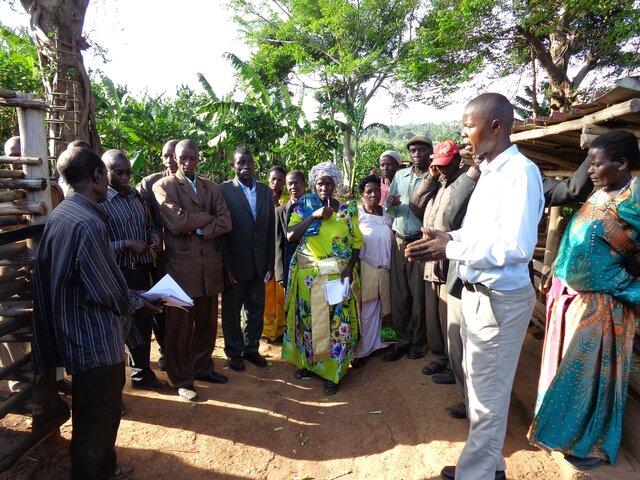
MADDO SLM approach [Ouganda]
This integrated soil fertility management approach aims at identifying and promoting practices in land management that can increase soil fertility, reduce land degradation and improve production. Under this specific example, organic manure from a piggery was applied to banana and coffee plantations.
- Compilateur : Tonny Kyambadde
2. Description de la Technologie de GDT
2.1 Courte description de la Technologie
Définition de la Technologie:
The "Piggery-Banana-Coffee" sustainable land management technology is a proven practice that significantly improves soil fertility and productivity in an integrated farming system for smallholder farmers in Uganda.
2.2 Description détaillée de la Technologie
Description:
The “piggery-banana-coffee” SLM technology has been widely practiced by smallholders in Bukumansimbi District, Central Uganda for many years. The technology is proven due to its manifold functions and benefits, including increased productivity and improved soil biodiversity leading to better food security with organic, healthy produce. It simultaneously contributes to environmental protection. The technology has been applied for many years in Bukumansimbi but it needed a promotion by the implementer Caritas MADDO for wider adaption by the community.
The technology can be applied in a natural environmental setting with no controlled conditions. Taking a case of one acre (0.4 ha) of land the farmer will need 450 coffee seedlings and 150 banana suckers to establish an integrated banana-coffee plantation. Then there is a requirement for 10 pigs to supply enough manure (urine and dung) to maintain the fertility of the soil in the plantation. Bananas provide shade to the coffee and reduce the impact of wind and soil erosion. Manure from the piggery is applied to the mixed plantation. Manure application increases soil biodiversity and improves both the physical and chemical properties of the soil, including soil structure, aeration, and moisture retention. Integrating piggery components into the system requires shed construction, purchase of piglets, feeding costs, treatment, and vaccinations. The pigsty occupies a space of 50 ft by 25 ft (approx. 15 m x 7.5 m). Each enterprise is complementary to the other: manure from pigs goes to the coffee and banana plantation and in return the banana peelings as well as the household food leftovers are served as important food resources for the pigs.
The land users under the pilot project acknowledge the significance of the technology because of its ability to sustain production and the other benefits listen above. However, swine fever disease is one of the limiting factors to the technology, as the pigs are prone to its outbreak. Moreover, some farmers report the high feeding costs for the pigs’ maintenance - particularly in the dry season (when there are few weeds that can be supplemented to the diet of the pigs).
2.3 Photos de la Technologie
2.5 Pays/ région/ lieux où la Technologie a été appliquée et qui sont couverts par cette évaluation
Pays:
Ouganda
Région/ Etat/ Province:
Central region
Autres spécifications du lieu:
Bigasa Sub County in Bukomansimbi District
Spécifiez la diffusion de la Technologie:
- répartie uniformément sur une zone
S'il n'existe pas d'informations exactes sur la superficie, indiquez les limites approximatives de la zone couverte:
- 0,1-1 km2
Est-ce que les sites dans lesquels la Technologie est appliquée sont situés dans des zones protégées en permanence?
Non
Map
×2.6 Date de mise en œuvre de la Technologie
Indiquez l'année de mise en œuvre:
2017
Si l'année précise est inconnue, indiquez la date approximative: :
- il y a moins de 10 ans (récemment)
2.7 Introduction de la Technologie
Spécifiez comment la Technologie a été introduite: :
- dans le cadre d'un système traditionnel (> 50 ans)
- par le biais de projets/ d'interventions extérieures
Commentaires (type de projet, etc.) :
The "piggery-banana-coffee” SLM technology has been practiced as a traditional system in the area for more than 50 years, however the project rebooted the technology and its adoption under the EEALIP project starting in 2017.
3. Classification de la Technologie de GDT
3.1 Principal(aux) objectif(s) de la Technologie
- améliorer la production
- réduire, prévenir, restaurer les terres dégradées
- préserver l'écosystème
- conserver/ améliorer la biodiversité
- créer un impact économique positif
3.2 Type(s) actuel(s) d'utilisation des terres, là où la Technologie est appliquée
Les divers types d'utilisation des terres au sein du même unité de terrain: :
Oui
Précisez l'utilisation mixte des terres (cultures/ pâturages/ arbres):
- Agroforesterie

Terres cultivées
- Cultures pérennes (non ligneuses)
Cultures pérennes (non ligneuses) - Précisez les cultures:
- bananier/plantain/abaca
- Coffee
Nombre de période de croissance par an: :
- 2
Précisez:
For banana the harvest is continuous through the year whiles as coffee has two harvesting seasons
Est-ce que les cultures intercalaires sont pratiquées?
Oui
Si oui, précisez quelles cultures sont produites en culture intercalaire:
Banana and coffee are intercropped
Est-ce que la rotation des cultures est appliquée?
Non

Forêts/ bois
- Plantations d'arbres, boisements
Plantation d'arbres, afforestation: Précisez l'origine et la composition des espèces. :
- Variétés mixtes
- Ficus natalensis (mutuba in luganda) tree
Est-ce que les espèces d’arbres précisées ci-dessus sont des espèces d'arbre arbres à feuilles caduques ou à feuilles persistantes ?
- forêts à feuillage persistant
Produits et services:
- Bois d'œuvre (de construction)
- Bois de chauffage
- Autres produits forestiers
- Pâturage/ broutage
- Conservation/ protection de la nature
- Loisirs/ tourisme
- Protection contre les aléas naturels
- Backcloth

Voies d'eau, plans d'eau, zones humides
- Marécages, zones humides
Principaux produits/ services:
Swamp is nearby for water supply
3.3 Est-ce que l’utilisation des terres a changé en raison de la mise en œuvre de la Technologie ?
Est-ce que l’utilisation des terres a changé en raison de la mise en œuvre de la Technologie ?
- Oui (Veuillez remplir les questions ci-après au regard de l’utilisation des terres avant la mise en œuvre de la Technologie)
Les divers types d'utilisation des terres au sein du même unité de terrain: :
Oui
Précisez l'utilisation mixte des terres (cultures/ pâturages/ arbres):
- Agro-sylvo-pastoralisme

Terres cultivées
- Cultures pérennes (non ligneuses)
Cultures pérennes (non ligneuses) - Précisez les cultures:
- bananier/plantain/abaca
- coffee
Est-ce que les cultures intercalaires sont pratiquées?
Oui
Si oui, précisez quelles cultures sont produites en culture intercalaire:
Banana and coffee are intercropped
Est-ce que la rotation des cultures est appliquée?
Non

Forêts/ bois
- Plantations d'arbres, boisements
Plantation d'arbres, afforestation: Précisez l'origine et la composition des espèces. :
- Variétés mixtes
- Ficus natalensis (mutuba in luganda) tree
Est-ce que les espèces d’arbres précisées ci-dessus sont des espèces d'arbre arbres à feuilles caduques ou à feuilles persistantes ?
- forêts à feuillage persistant
Produits et services:
- Bois d'œuvre (de construction)
- Bois de chauffage
- Autres produits forestiers
- Pâturage/ broutage
- Conservation/ protection de la nature
- Loisirs/ tourisme
- Protection contre les aléas naturels

Voies d'eau, plans d'eau, zones humides
- Marécages, zones humides
Principaux produits/ services:
Swamp is nearby for water supply
Commentaires:
Pigs are kept on zero grazing. There are not allowed to roam in the bananas or coffee farm.
3.4 Approvisionnement en eau
Approvisionnement en eau des terres sur lesquelles est appliquée la Technologie:
- pluvial
Commentaires:
The land is mulched with dry grass and banana materials to conserve rainfed water from evaporation.
3.5 Groupe de GDT auquel appartient la Technologie
- agroforesterie
- gestion intégrée cultures-élevage
- gestion intégrée de la fertilité des sols
3.6 Mesures de GDT constituant la Technologie

pratiques agronomiques
- A1: Couverture végétale/ du sol
- A2: Matière organique/ fertilité du sol
- A3: Traitement de la couche superficielle du sol
- A7: Autres
A3: Différenciez les systèmes de travail du sol:
A 3.2: Reduced tillage (> 30% soil cover)

pratiques végétales
- V1: Couverture d’arbres et d’arbustes
- V2: Herbes et plantes herbacées pérennes
- V3: Défrichement de la végétation

structures physiques
- S1: Terrasses
- S9: Abris pour plantes et animaux
3.7 Principaux types de dégradation des terres traités par la Technologie

érosion hydrique des sols
- Wt: perte de la couche superficielle des sols (couche arable)/ érosion de surface
- Wo: effets hors-site de la dégradation

dégradation chimique des sols
- Cp: pollution des sols

dégradation biologique
- Bq: baisse de la quantité/ biomasse
- Bs: baisse de la qualité et de la composition/ diversité des espèces
- Bl: perte de la vie des sols
- Bp: augmentation des insectes nuisibles (ravageurs)/ maladies, baisse des prédateurs

dégradation hydrique
- Hq: baisse de la qualité des eaux souterraines
Commentaires:
The technology is promoting better quality of groundwater on two grounds. Firstly, by applying the organic manure of the pigs on the coffee and banana farm instead of chemical fertilizers no pollution of the waterbodies is given. Secondly, the pigs are confined in their pigs sty and thus due not have the opportunity to go to the water bodies and pollute the water with urine or dung.
3.8 Prévention, réduction de la dégradation ou réhabilitation des terres dégradées
Spécifiez l'objectif de la Technologie au regard de la dégradation des terres:
- prévenir la dégradation des terres
- réduire la dégradation des terres
Commentaires:
The major purpose for this technology is to prevent soil degradation and improve soil fertility.
4. Spécifications techniques, activités, intrants et coûts de mise en œuvre
4.1 Dessin technique de la Technologie
Spécifications techniques (associées au dessin technique):
Technical specifications of the pig sty construction
Auteur:
Kyambadde, Tonny
Date:
19/04/2021
Spécifications techniques (associées au dessin technique):
Technical specifications of the coffee and banana integration
Auteur:
Kyambadde, Tonny
Date:
13/07/2023
4.2 Informations générales sur le calcul des intrants et des coûts
Spécifiez la manière dont les coûts et les intrants ont été calculés:
- par superficie de la Technologie
Indiquez la taille et l'unité de surface:
one hectare
autre/ monnaie nationale (précisez):
Uganda Shilling
Indiquez le taux de change des USD en devise locale, le cas échéant (p.ex. 1 USD = 79.9 réal brésilien): 1 USD = :
3750,0
Indiquez le coût salarial moyen de la main d'œuvre par jour:
no labour was hired
4.3 Activités de mise en place/ d'établissement
| Activité | Calendrier des activités (saisonnier) | |
|---|---|---|
| 1. | Land clearing and preparation | once a year |
| 2. | Hole digging | once |
| 3. | Coffee and banana planting | once |
| 4. | Pig sty (house) construction | once |
| 5. | Purchase of pigs | once |
4.4 Coûts et intrants nécessaires à la mise en place
Si vous n'êtes pas en mesure de décomposer les coûts dans le tableau précédent, donnez une estimation du coût total de la mise en place de la Technologie:
5300000,0
Si le coût n'est pas pris en charge à 100% par l'exploitant des terres, indiquez qui a financé le coût restant:
The Euregio project contributed two pigs and some starter coffee seedlings and banana suckers (roughly 35 % of total establishment costs were catered by the project).
Commentaires:
These costs include the clearing of the land and prior establishment of the coffee and banana plantation. The majority of the costs are attributed to the purchase of pigs and the construction of the pig sty (roughly 3 million UGX).
4.5 Activités d'entretien/ récurrentes
| Activité | Calendrier/ fréquence | |
|---|---|---|
| 1. | Weeding and garden clearing | Twice a seaon |
| 2. | Manure application | At the onset of rain season |
| 3. | Feeding and watering of pigs | On daily basis |
| 4. | Treatment and deworming of pigs | On monthly basis |
| 5. | Mulching of the garden | Once a year or more |
| 6. | Contour digging | once a year |
| 7. | Pruning of coffee and banana plantation | For banana its done twice a season and for coffee its done every after harvesting season. |
| 8. | Maintenance of piggery sty | once a year |
4.6 Coûts et intrants nécessaires aux activités d'entretien/ récurrentes (par an)
Si vous n'êtes pas en mesure de décomposer les coûts dans le tableau précédent, donnez une estimation du coût total de l'entretien de la Technologie:
500000,0
Commentaires:
Estimation of 500,000 UGX per year. Most costs are for the treatment for the pigs and the maintenance of the pigsty. The rest is covered by family labour.
4.7 Facteurs les plus importants affectant les coûts
Décrivez les facteurs les plus importants affectant les coûts :
Most costs are connected to the piggery in particular the maintenance of the pigs. Animal diseases and the resulting costs for the treatments are unplanned expenses.
5. Environnement naturel et humain
5.1 Climat
Précipitations annuelles
- < 250 mm
- 251-500 mm
- 501-750 mm
- 751-1000 mm
- 1001-1500 mm
- 1501-2000 mm
- 2001-3000 mm
- 3001-4000 mm
- > 4000 mm
Spécifiez la pluviométrie moyenne annuelle (si connue), en mm:
1200,00
Spécifications/ commentaires sur les précipitations:
The rainfall pattern is bimodal, having two seasons. The two dry spell seasons are between January - March and between June to August, with the winter seasons between March to May and September to December.
Indiquez le nom de la station météorologique de référence considérée:
Uganda metrological authority
Zone agro-climatique
- subhumide
The average maximum temperature doesn't exceed 30 degrees Celcius and the minimum temperature is not below 10 degrees Celcius with almost equal length of the day and night through out the year.
The humidity level is relatively low through out the area.
5.2 Topographie
Pentes moyennes:
- plat (0-2 %)
- faible (3-5%)
- modéré (6-10%)
- onduleux (11-15%)
- vallonné (16-30%)
- raide (31-60%)
- très raide (>60%)
Reliefs:
- plateaux/ plaines
- crêtes
- flancs/ pentes de montagne
- flancs/ pentes de colline
- piémonts/ glacis (bas de pente)
- fonds de vallée/bas-fonds
Zones altitudinales:
- 0-100 m
- 101-500 m
- 501-1000 m
- 1001-1500 m
- 1501-2000 m
- 2001-2500 m
- 2501-3000 m
- 3001-4000 m
- > 4000 m
5.3 Sols
Profondeur moyenne du sol:
- très superficiel (0-20 cm)
- superficiel (21-50 cm)
- modérément profond (51-80 cm)
- profond (81-120 cm)
- très profond (>120 cm)
Texture du sol (de la couche arable):
- moyen (limoneux)
Texture du sol (> 20 cm sous la surface):
- moyen (limoneux)
Matière organique de la couche arable:
- moyen (1-3%)
Si disponible, joignez une description complète du sol ou précisez les informations disponibles, par ex., type de sol, pH/ acidité du sol, capacité d'échange cationique, azote, salinité, etc.
The soils ranging from red laterite, sandy loam and loam.
Soils are generally ferrallisol characterized by red colored sandy clay loams and sandy loams, but relatively productive.
5.4 Disponibilité et qualité de l'eau
Profondeur estimée de l’eau dans le sol:
5-50 m
Disponibilité de l’eau de surface:
moyenne
Qualité de l’eau (non traitée):
faiblement potable (traitement nécessaire)
La qualité de l'eau fait référence à:
à la fois les eaux souterraines et de surface
La salinité de l'eau est-elle un problème? :
Non
La zone est-elle inondée?
Non
Commentaires et précisions supplémentaires sur la qualité et la quantité d'eau:
Major source of water supply is swamp and readily available all the time in both seasons dry and rain season
5.5 Biodiversité
Diversité des espèces:
- élevé
Diversité des habitats:
- moyenne
Commentaires et précisions supplémentaires sur la biodiversité:
No official statistics available, but Banana plantations usually have higher diversity with up to 15 species of other crops within.
5.6 Caractéristiques des exploitants des terres appliquant la Technologie
Sédentaire ou nomade:
- Sédentaire
Orientation du système de production:
- exploitation mixte (de subsistance/ commerciale)
- commercial/ de marché
Revenus hors exploitation:
- moins de 10% de tous les revenus
Niveau relatif de richesse:
- pauvre
Individus ou groupes:
- groupe/ communauté
Niveau de mécanisation:
- travail manuel
Genre:
- femmes
- hommes
Age des exploitants des terres:
- jeunes
- personnes d'âge moyen
- personnes âgées
5.7 Superficie moyenne des terres utilisées par les exploitants des terres appliquant la Technologie
- < 0,5 ha
- 0,5-1 ha
- 1-2 ha
- 2-5 ha
- 5-15 ha
- 15-50 ha
- 50-100 ha
- 100-500 ha
- 500-1 000 ha
- 1 000-10 000 ha
- > 10 000 ha
Cette superficie est-elle considérée comme de petite, moyenne ou grande dimension (en se référant au contexte local)?
- petite dimension
Commentaires:
In Central Uganda 1-2 ha is considered small scale. It might be different in other regions of Uganda.
5.8 Propriété foncière, droits d’utilisation des terres et de l'eau
Propriété foncière:
- individu, sans titre de propriété
- individu, avec titre de propriété
Droits d’utilisation des terres:
- individuel
Droits d’utilisation de l’eau:
- accès libre (non organisé)
Est-ce que les droits d'utilisation des terres sont fondés sur un système juridique traditionnel?
Oui
5.9 Accès aux services et aux infrastructures
santé:
- pauvre
- modéré
- bonne
éducation:
- pauvre
- modéré
- bonne
assistance technique:
- pauvre
- modéré
- bonne
emploi (par ex. hors exploitation):
- pauvre
- modéré
- bonne
marchés:
- pauvre
- modéré
- bonne
énergie:
- pauvre
- modéré
- bonne
routes et transports:
- pauvre
- modéré
- bonne
eau potable et assainissement:
- pauvre
- modéré
- bonne
services financiers:
- pauvre
- modéré
- bonne
6. Impacts et conclusions
6.1 Impacts sur site que la Technologie a montrés
Impacts socio-économiques
Production
production agricole
Quantité avant la GDT:
1
Quantité après la GDT:
3
Commentaires/ spécifiez:
Significant improvement in coffee production was noticed jumping from an average yield increase of 300kg to 700kg of coffee harvest in one acre per season. Size of banana bunches with an average increase in weight from from 12kg to 30kg.
qualité des cultures
Quantité avant la GDT:
0
Quantité après la GDT:
2
Commentaires/ spécifiez:
Coffee beans improved a lot in terms of size and quality, with over 70% coffee beans harvested in the category of screen 18 (super beans). The banana size and its fingers improved in size, and the taste of banana food greatly improve with a pleasant aroma, softer on eating and cooks faster compared to previously produced bananas.
production animale
Commentaires/ spécifiez:
The production of pigs increased substantially in a time period of a year. The participating farmers started with 3 pigs at the beginning and reached an increase of pigs to an average 15 pigs after a year (2 breeding cycles per pig per year).
gestion des terres
Quantité avant la GDT:
-2
Quantité après la GDT:
3
Commentaires/ spécifiez:
The farming system employed by the farmers previously before introduction of the technology was not sustainable. Resources were being continuously depleted by crop practices employed without replacement of what is lost from the soil during harvest. integration of piggery into the system improved soil fertility with manure composted from piggery wastes. Besides boosting soil fertility, biodiversity on the farm improved as well (the soil organisms, new plant species emerged, insect species among others) the green biomass and overall soil health improved.
Revenus et coûts
revenus agricoles
Commentaires/ spécifiez:
The average farm income before the technology was very little and did not support the family's basic home needs. With the introduction of the technology, the household income improved from an average of monthly 45.000 UGX to 150.000 UGX. However, it is important to note that this is not a fixed monthly income and is depending on the harvest season. Thus, there are peak income phases followed by low seasons.
diversité des sources de revenus
Commentaires/ spécifiez:
More income sources were established through the three enterprises (coffee, banana and piggery).
Impacts socioculturels
sécurité alimentaire/ autosuffisance
Quantité avant la GDT:
0
Quantité après la GDT:
2
Commentaires/ spécifiez:
With improved soil fertility resulting in bigger sizes of banana bunches, improved food security was achieved. The increased income from coffee and piggery ensured availability of alternative food supply though their sale.
situation sanitaire
Quantité avant la GDT:
-1
Quantité après la GDT:
2
Commentaires/ spécifiez:
There was less exposure to agriculture chemical by farmers and the entire community at large which poses health threat to the people and cause environment damage. the quality of food produced was free from any chemical residues emanating from synthetic fertilizers.
connaissances sur la GDT/ dégradation des terres
Commentaires/ spécifiez:
Through the technology farmers were able to learn how important it is to use organic sources of fertilizer and its benefits to the environment and soil health. MADDO facilitated roughly 15 different training sessions for the participating farmer group targeting the soil and water conservation practices.
situation des groupes socialement et économiquement désavantagés
Commentaires/ spécifiez:
The situation of women (average between 40-55 years old) was improved through the technology by giving them access and knowledge to this pilot project. The mobilization and right selection of participants were crucial for the improvement.
Impacts écologiques
Sols
humidité du sol
Commentaires/ spécifiez:
Higher retention of soil moisture
matière organique du sol/ au dessous du sol C
Commentaires/ spécifiez:
Better composition of soil nutrients with increased population of soil organisms (micro and macro)
Biodiversité: végétale, animale
biomasse/ au dessus du sol C
diversité des habitats
Commentaires/ spécifiez:
Organic manure provided a conducive environment for multiplication and survival of living organisms
Précisez l'évaluation des impacts sur site (sous forme de mesures):
All the impacts are based on estimations. Thereby, assessments by farmers have been added with observations from the staff to get a clear understanding of the impacts.
6.2 Impacts hors site que la Technologie a montrés
Pollution of water
Commentaires/ spécifiez:
The usage of organic manure instead of chemical fertilizers reduced the pollution of downstream water from fields
Précisez l'évaluation des impacts extérieurs (sous forme de mesures):
This impact is based on estimation by the project staff as well as some observations from participants.
6.3 Exposition et sensibilité de la Technologie aux changements progressifs et aux évènements extrêmes/catastrophes liés au climat (telles que perçues par les exploitants des terres)
Commentaires:
The technology was piloted in a 3-year program and climate-related consequences cannot be measured yet.
6.4 Analyse coûts-bénéfices
Quels sont les bénéfices comparativement aux coûts de mise en place (du point de vue des exploitants des terres)?
Rentabilité à court terme:
positive
Rentabilité à long terme:
très positive
Quels sont les bénéfices comparativement aux coûts d'entretien récurrents (du point de vue des exploitants des terres)?
Rentabilité à court terme:
positive
Rentabilité à long terme:
légèrement positive
Commentaires:
After the establishment of the technology, the returns from coffee are attained in period of two years, for banana returns observed in less than one year and for piggery profits attained in period of less than two years.
6.5 Adoption de la Technologie
- 11-50%
Si disponible, quantifiez (nombre de ménages et/ou superficie couverte):
Mainstreaming of the technology was promoted through copying from the participants and also due to the promotion by the district field staff. The technology has been in existence for years and that is why a high adoption can be observed.
De tous ceux qui ont adopté la Technologie, combien d'entre eux l'ont fait spontanément, à savoir sans recevoir aucune incitation matérielle, ou aucune rémunération? :
- 51-90%
Commentaires:
The technology is commonly used in the area. However, those who were not part of the program take short-cuts or do not have such high positive progress as the others.
6.6 Adaptation
La Technologie a-t-elle été récemment modifiée pour s'adapter à l'évolution des conditions?
Non
6.7 Points forts/ avantages/ possibilités de la Technologie
| Points forts/ avantages/ possibilités du point de vue de l'exploitant des terres |
|---|
| Contributes positively to the soil fertility. |
| Improves the food security and household income |
| Points forts/ avantages/ possibilités du point de vue du compilateur ou d'une autre personne ressource clé |
|---|
| Farmers were able to local available resources for this technology. |
| It improved the soil health and contributed to environmental conservation. |
6.8 Faiblesses/ inconvénients/ risques de la Technologie et moyens de les surmonter
| Faiblesses/ inconvénients/ risques du point de vue de l’exploitant des terres | Comment peuvent-ils être surmontés? |
|---|---|
| Diseases that affect the piggery (swine fewer). | No mitigation (vaccination) available. |
| The vet officers are not always available for vaccinations or treatments for the pigs. Moreover, there are quite expensive. | Farmers group together to lobby for the service. |
| Faiblesses/ inconvénients/ risques du point de vue du compilateur ou d'une autre personne ressource clé | Comment peuvent-ils être surmontés? |
|---|---|
| Follow up on the management practices for the piggery were time consuming. | Establishment of community-based trainers (CBT) that take over |
7. Références et liens
7.1 Méthodes/ sources d'information
- interviews/entretiens avec les exploitants des terres
About 30 participants
- interviews/ entretiens avec les spécialistes/ experts de GDT
Interview with two experts from the district (agriculture officer and production officer).
- compilation à partir de rapports et d'autres documents existants
The following sources was used:
Ministry of Agriculture, Animal Industry and Fisheries (2014): Uganda Training Materials for Coffee Production. Trainer's Guide. First Edition.
Quand les données ont-elles été compilées (sur le terrain)?
26/05/2021
7.2 Références des publications disponibles
Titre, auteur, année, ISBN:
Benefits of sustainable land management, UNCCD
Disponible à partir d'où? Coût?
https://catalogue.unccd.int/838_Benefits_of_SLM_eng.pdf
7.3 Liens vers les informations pertinentes en ligne
Titre/ description:
Sustainable Agriculture in Africa,
URL:
https://wedocs.unep.org/bitstream/handle/20.500.11822/34621/RSRSA.pdf?sequence=3&isAllowed=y
Liens et modules
Développer tout Réduire toutLiens

MADDO SLM approach [Ouganda]
This integrated soil fertility management approach aims at identifying and promoting practices in land management that can increase soil fertility, reduce land degradation and improve production. Under this specific example, organic manure from a piggery was applied to banana and coffee plantations.
- Compilateur : Tonny Kyambadde
Modules
Aucun module trouvé


